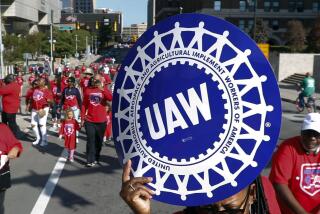GM Fund for Laid-Off Workers in Danger : Autos: UAW is told the $3.35 billion will run out by year’s end, sources say. That could trigger an early reopening of the company’s labor agreement.
- Share via
DETROIT — As pressures mount on struggling General Motors Corp. to cut costs and increase productivity, the company has told the United Auto Workers union that its $3.35-billion fund assuring virtually full pay to laid-off workers will run out by year’s end, sources said Wednesday.
Company and union watchers said the prospect of income plummeting for about 37,000 idled workers now collecting GM layoff pay could trigger the reopening of their labor agreement far ahead of September, 1993, when the contract and the pension fund were scheduled for renegotiation. The only other time the UAW reopened a labor agreement with an auto maker was in the early 1980s, during the industry’s last crisis.
For the record:
12:00 a.m. Oct. 16, 1992 For the Record
Los Angeles Times Friday October 16, 1992 Home Edition Business Part D Page 2 Column 6 Financial Desk 2 inches; 38 words Type of Material: Correction
General Motors: A story in Thursday’s editions incorrectly suggested that a fund for laid-off General Motors Corp. workers that is running out of money would affect retirees. The fund applies to workers laid off through September, 1993, when their contract expires.
The fund’s shortfall could also give GM leverage in what so far has been an uphill struggle with the union to slash production costs and reduce massive losses in the North American car and truck business.
The looming problem with layoff pay is just one cross-current in the volatile relationship between GM and the UAW in recent weeks, as the company falls short of its cost-cutting goals and loses more ground in the auto market.
Tensions are also building as GM prepares to announce another round of plant closings and layoffs toward its stated goal of padlocking 21 plants and eliminating 74,000 jobs by mid-decade. The announcement is expected next month, shortly after GM discloses a third-quarter loss projected to be about $750 million.
Non-management members of GM’s board of directors have reportedly stepped up their pressure on Chairman Robert C. Stempel to wring new efficiencies from its blue-collar work force. Published accounts of that pressure have provoked angry rhetoric from UAW leaders.
Stempel, meanwhile, remained in a Washington, D.C., hospital Wednesday where his condition was upgraded to “good.” He was rushed there by ambulance Tuesday after falling ill at lunch.
GM said Wednesday that Stempel’s problem was diagnosed as high blood pressure that has been “corrected” by treatment. He is expected to be released today and be back in his office in Detroit on Friday, GM said.
Harley Shaiken, a labor expert at UC Berkeley, contends that GM would like to use its current turmoil “to gain more, longer-lasting concessions from the union. And the (layoff fund) going bust might create pressures to return to the table early.”
But the two sides appear to be struggling to cooperate in cutting costs at specific plants, notably at an Anderson, Ind., component factory, where a strike was headed off last week after an agreement that saved jobs in return for cost-cutting concessions.
Stempel, 59, has been under intense pressure since he was named chairman and chief executive and GM’s fortunes tumbled with the economy. Last winter, after GM posted a $4.45-billion 1991 loss that was the worst in U.S. corporate history, his responsibilities were trimmed in an uprising by outside directors, who replaced his hand-picked president with John F. Smith Jr.
Since then, GM has undergone rapid change in Smith’s effort to reform the company’s insular culture and hack away at overhead that has made it far less efficient than its nimbler U.S. rivals. But the board isn’t satisfied with the progress.
Neither GM nor union officials would comment on when the money will run out for laid-off workers. A well-placed company source said it could happen within six weeks, leaving idled workers with weekly state unemployment checks. This source said GM’s Smith notified UAW Vice President Stephen Yokich of the pending crunch at a meeting last week.
UAW officials downplayed the seriousness of the situation. A spokesman called it “no big deal.” Union leaders are said to have voiced skepticism about the veracity of GM’s claims that the money was running out.
But others said the outflow of cash could quicken dramatically as GM shuts more plants and throws more workers on the street. “It’s just 36,000 workers now,” another union member said. “What if they close seven more plants next month?”
The $3.35 billion is the sum GM pledged toward layoff pay over the three years of its 1990 labor agreement, a step seen at the time as buying labor peace while at the same time letting GM pursue plans to close plants and eliminate jobs.
But the pact was signed weeks before consumer confidence collapsed in the wake of Iraq’s invasion of Kuwait, triggering a recession that caused more and longer auto layoffs than anyone expected. That has swallowed up GM’s layoff contribution at a rate of more than $1 billion a year, about what its touted European subsidiary earned last year.
In a statement Tuesday complaining about GM’s directors, Yokich added a conciliatory note, insisting that the union “recognizes that GM has real problems that require real solutions. . . . We are demonstrating daily that we are quite prepared to be a part of those solutions.”
Still, the UAW has rebuffed previous overtures from Stempel to rework the costly 1990 labor agreement ahead of time. The auto firm says terms of the agreement--such as a requirement that it hire one worker for every two that are laid off--are blocking its efforts to become more competitive.






